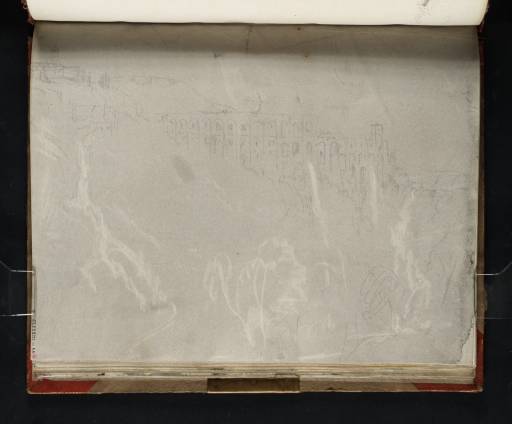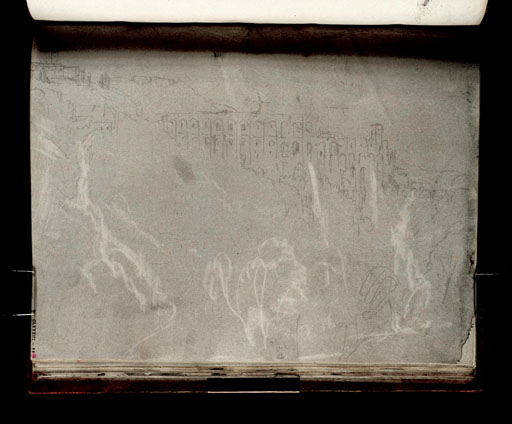Joseph Mallord William Turner View of Tivoli, with the Santuario di Ercole Vincitore 1819
Image 1 of 2
Joseph Mallord William Turner,
View of Tivoli, with the Santuario di Ercole Vincitore
1819
Joseph Mallord William Turner 1775–1851
Folio 36 Recto:
View of Tivoli, with the Santuario di Ercole Vincitore 1819
D15503
Turner Bequest CLXXXIII 36
Turner Bequest CLXXXIII 36
Pencil and grey watercolour wash on white wove paper, 200 x 253 mm
Inscribed by ?John Ruskin in faded red ink ‘36’ bottom left, descending left-hand edge
Stamped in black ‘CLXXXIII 36’ bottom left, descending left-hand edge
Inscribed by ?John Ruskin in faded red ink ‘36’ bottom left, descending left-hand edge
Stamped in black ‘CLXXXIII 36’ bottom left, descending left-hand edge
Accepted by the nation as part of the Turner Bequest 1856
References
1909
A.J. Finberg, A Complete Inventory of the Drawings of the Turner Bequest, London 1909, vol.I, p.541, as ‘Tivoli’.
Turner’s exploration of Tivoli included a large number of landscape sketches drawn from the river valley to the north. He was particularly attracted by the spectacle of the town’s ancient ruins perched above the steep, wooded gorge and streaming cascatelli (or cascatelle), the lesser cascades. This study depicts the view looking from the opposite side of the valley towards the long arcades of the Santuario di Ercole Vincitore (Sanctuary of Hercules the Victor), a Roman temple dating from the first century BC, dedicated to the cult of Hercules. Rising above the temple in the background to the left is the Villa d’Este and the campanile of the adjacent Church of Santa Maria Maggiore. Turner’s viewpoint is a location near the ruins of the Villa of Quintilius Varus, adjacent to the Santuario di Quintiliolo (Church of the Madonna of Quintiliolo) situated on the northern slopes of the valley. Like many drawings within this sketchbook, the composition has been executed over a washed grey background. Turner has created highlights within the work by rubbing or lifting out the wash to reveal the white paper beneath, principally to create the silvery streams of the cascades below the substructures of the temple.
Formerly known as the Villa of Maecenas, the Santuario di Ercole Vincitore was one of Tivoli’s most famous landmarks and its picturesque qualities had made it a popular subject for artists. Revd John Chetwode Eustace in A Classical Tour Through Italy, first published in 1813, recommended the view from the opposite side of the valley where ‘the towers of the town rising on the top of the hill beyond the cascade, with the ruins of Maecenas’s villa on its shelving side, form one of the most delicious pictures for softness and beauty, wildness and animation, that can be imagined.’1 He described the temple as Turner would have seen it:
Maecenas’s villa [Santuario di Ercole Vincitore] stands at the extremity of the town on the brow of the hill and hangs over several streamlets which fall down the steep. It commands a noble view of the Anio [Aniene] and its vale beneath, the hills of Albano and Monticelli, the Campagna, and Rome itself rising on the borders of the horizon. It still presents several traces of its former magnificence, such as a triple row of arches, seventeen below and fourteen above ... The active Cardinal Ruffo during the reign of the late pontiff, turned it into a foundry, after having stripped the walls and the roof of the ivy, and effaced the venerable marks of ruin which the hand of time had shed over them. A branch of the river pours through the arched gallery and vaulted cellars, and shaking the edifice as it passes along, rushes in several sheets down the declivity.2
The Santuario features in many of Turner’s 1819 sketches looking both up and down the valley, and he also made detailed tonal studies of the architecture and the arched passageway underneath the substructures, see folio 5 (D15471). More detailed views from the Villa of Quintilius Varus can be seen on folios 17 and 23 (D15483 and D15489). It was the vista from the north-east, however, which seems to have held the most enduring visual appeal for the artist and which was ultimately developed within more finished work, see folio 3 (D15469).
Verso:
Blank, except for traces of grey watercolour wash
Blank, except for traces of grey watercolour wash
Nicola Moorby
February 2010
How to cite
Nicola Moorby, ‘View of Tivoli, with the Santuario di Ercole Vincitore 1819 by Joseph Mallord William Turner’, catalogue entry, February 2010, in David Blayney Brown (ed.), J.M.W. Turner: Sketchbooks, Drawings and Watercolours, Tate Research Publication, December 2012, https://www


